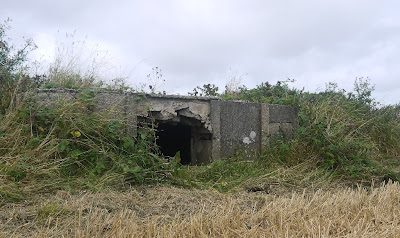The Stent Pillbox is basically a prefabricated pillbox constructed of 'hollow concrete sections bolted together and filled with rubble and/or poured concrete' (M Osborne- Pillboxes of Britain and Ireland). Typically these pillboxes resembled the Type 26 square pillbox although some were apparently a 'double version', of which the Filey example is almost certainly one. It's dimensions are approx 20' x 11' with a central brick dividing / Anti-ricochet wall. The pillbox has at least six embrasures (possibly more but a section of wall is destroyed). Three of the embrasures would appear to be typical pre-cast embrasures for a rifle or light machine gun with a weapons shelf but three are much wider and have a recess low down in the inner wall - I have no idea what weapon these were for.
The pillbox would seem to be filled with rubble / poor quality concrete. Chalk can clearly be seen to have been used to infill parts. Personally, if I had been facing the enemy I would rather have taken my chances in the open than in this pillbox - I cannot see how it would have even been bullet proof.
On an interesting note, I had forward to me a note in a war diary about the erection of an 'experimental' Stent in the Yarmouth area - the first I've heard of this type of pillbox in Norfolk/Suffolk - certainly a lead to follow up on.
The pillbox would seem to be filled with rubble / poor quality concrete. Chalk can clearly be seen to have been used to infill parts. Personally, if I had been facing the enemy I would rather have taken my chances in the open than in this pillbox - I cannot see how it would have even been bullet proof.
On an interesting note, I had forward to me a note in a war diary about the erection of an 'experimental' Stent in the Yarmouth area - the first I've heard of this type of pillbox in Norfolk/Suffolk - certainly a lead to follow up on.
Above: Sketch plan of Stent Pillbox, Filey (NOT TO SCALE)
Above: Interior of pillbox - note the two types of embrasure (and the lower recess in the large type of embrasure). Last image shows the entrance and interior brick wall which would have given some strength to the pillbox and also acted in part as an Anti-ricochet wall.
Above: The exterior of the pillbox. Note the standard pre-cast small embrasure (last two images) and the large type of embrasure (top image - albeit damaged). Note also in the second image the chalk rubble used to infill the pillbox.
I must admit to have done no research into Yorkshire so cannot offer any more details on this pillbox than above. If anyone knows the intended role of this pillbox or the weapon the larger type of embrasure was designed for please leave a comment!!










Comments
Post a Comment